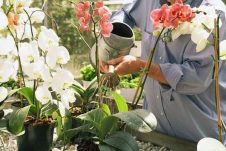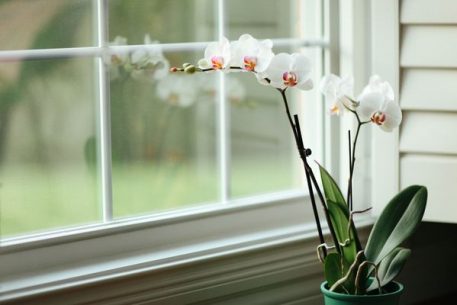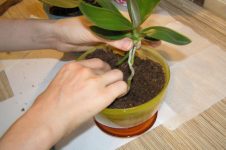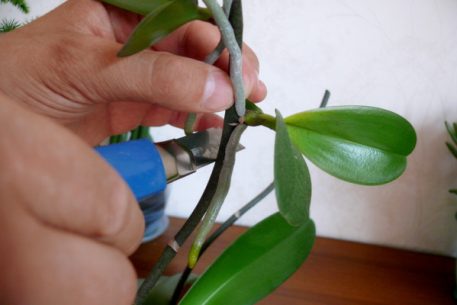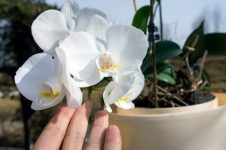White orchid is popular for good reason, its beautiful flowers are very reminiscent of fantastic butterflies. The plant looks great - snow-white large petals, seemingly wax-like, form a beautiful flower pattern, framing a tender core. The most famous variety is called phalaenopsis. This type of orchid is the most common, because Phalaenopsis blooms three times a year, delighting the owners. The main thing is that the care is correct.
Material Content:
Plant description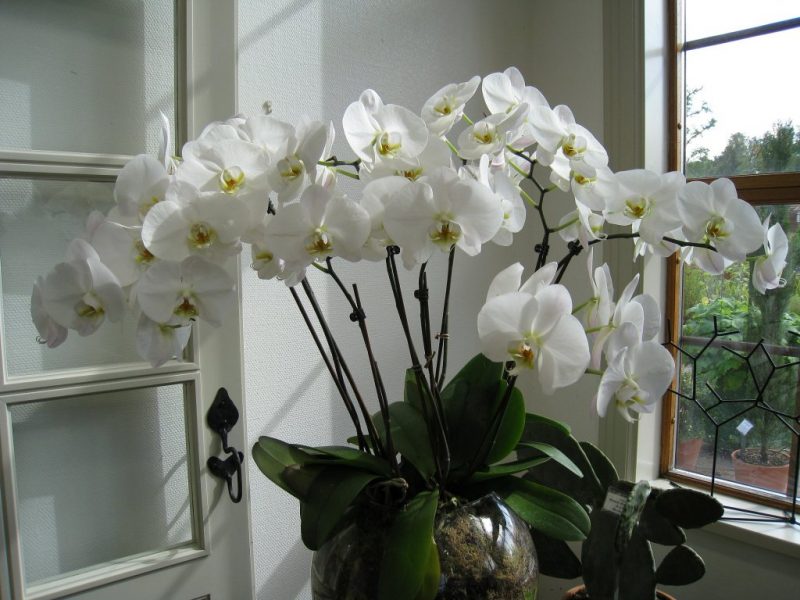
The structure of a white orchid is usually a long curved stem with a peduncle, on which flowers form. The leaves are dense, the size can be different, the amount is up to 10 pieces per plant.
Depending on the variety of orchids, they can be of different sizes: from very large, up to a meter in height, to small ones - 30 centimeters. Large orchid flowers are nearly 13 centimeters in diameter.
The shape of the flowers of all white orchids is the same - like moths to rest on the stem, to rest on the stem. There is no aroma, which is very important for a houseplant. After all, a strong aroma in the room is not always appropriate.
Varieties that are most often chosen for themselves by lovers of indoor orchids:
• White phalaenopsis orchid - a beautiful pure white flower, large, diameter up to 15 cm with a yellowish center, the total height of the trunk - 1 m. This is a standard view. It happens and miniature with a trunk of 30 cm and small flowers.
• Almeria is an amazingly beautiful flower.Its white petals are decorated with maroon spots, like splattered ink.
• Apple Blossom - classic white with medium colors up to 8 cm in size. It has a beautifully colored pinkish-orange core.
Growing Features
Orchid is known to be a rather capricious plant. To make it bloom, you need to not only take good care of it. When she is comfortable, she does not want to grow a peduncle. Then resort to some tricks to provoke flowering.
Dramatically change the conditions of detention in order to bring the plant out of equilibrium. For example, restrict watering or move to a place with a lower ambient temperature. Among fans of exotic flowers there are tales that the orchid began to bloom unexpectedly after its pot was accidentally overturned. Although, of course, this is a myth.
One of the important features of the same phalaenopsis, its almost year-round flowering. The fact is that not all flowers bloom at once on the peduncle. Some fade, and those that appear a little later are revealed.
Orchids often do not like stagnant indoor air. They love when there is air movement, a very weak breeze. Of course, drafts are not recommended, but you need to ventilate the room every day. Sometimes it’s useful to turn on the fan, but so that the air stream is not directed at the plant.
Optimal flower conditions
The natural conditions in which the orchid lives in nature are tropical forests. Moreover, this plant lives in that part of the forest where there is no direct sunlight. Its distribution zone is located on tree roots protruding from the ground, trunks. At the same time, the roots of the orchid itself are practically open and even take part in photosynthesis. Therefore, too hot and sunny space does not suit them. The temperature in the room should not exceed 25 degrees during the day, and at night drop to 16 degrees. The flower pot is necessarily transparent, the roots need diffused light access.
Read also:alocasia - home care
White orchid care at home
Flower shops sell a variety of white orchids. However, these are not at all those plant species that grow in nature, but hybrids. They are well adapted to artificial conditions. Therefore, "domesticated" orchids feel great indoors and are well developed. However, attention should be paid, of course, they need to be - water and fertilize the soil on time.
A healthy flower usually has a pale gray hue. If you suddenly notice that the color of the roots has changed, then this may indicate a fungal infection, and urgent measures should be taken here. Especially you need to pay attention to this fact when buying a plant.
The fungus begins to develop when the plant is improperly watered. Keep in mind that tropical rainforest organisms love moisture. However, due to the peculiarities of the structure and growth of orchids in nature, it consumes moisture not only from the substrate, but also from the air.
Therefore, it should not be watered often, but abundantly. The soil should dry well before the next watering. A break is from three to seven days in the summer, but much less often in the winter.
From time to time, the plant should be sprayed with clean water, saturating the air with moisture. This is an imitation of the atmosphere of a rainforest. The main thing is not to spray moisture directly onto the flowers. If the drops fall into the core of the flower, or linger too long in the leafy outlet, this can trigger the appearance of rot.
Plant propagation methods
Before starting the process of reproduction, the flower must first be well fertilized with phosphorus-potassium fertilizers. Care for him must be almost perfect.
The plant for reproduction must be taken by adults, at least three years old. Pay attention to the root system.Only specimens with well-developed roots are suitable. Orchid is ready for the process only if beautiful powerful leaves have developed on the trunk, at least five pieces.
There are only three ways of propagating in an orchid:
• seeds - this is the most difficult way; growing a full-fledged flower from seeds is difficult enough, especially for non-professionals;
• dividing the outlet - a relatively simple method that is available to every lover of home orchids;
• flower stalk or children - also a very simple method of reproduction, which a beginner grower will cope with;
The main condition is that the instruments to be used are sterilized.
All wounds that were inflicted on the plant, cutting off its parts, must be treated with natural antiseptics. These are the usual solutions of activated carbon, brilliant green or turmeric. Use only boiled water and above room temperature, lukewarm to the touch.
Pests and diseases of the white orchid
The white orchid, of course, has its own diseases and pests. Orchid in a pot can be infected even when buying or using a poorly disinfected substrate, with improper care.
Pests are terrible because they eat young shoots of leaves, drink the juice of a plant. And such a pest as an aphid covers the surface of the stems and leaves with a sticky substance that prevents the plant from breathing, poisoning the flowers with the products of their vital activity. As a result, the leaves dry and fall off, the orchid ceases to bloom.
The main types of pests:
1. Thrips are small insects, black bugs with hard wings folded on the back. They are difficult to see, because most often they hide in the substrate. However, they leave traces by which it can be understood that the plant is infected, black dots on the surface of the leaves and slightly shining paths. You can get rid of them only with the help of three times a week spraying with special preparations - Itoverm, Actellika.
2. Scutellaria, false scutellaria - these are fairly common insects, two species of them are dangerous for orchids. They can be noticed when strange tubercles of brown or yellow color appear on the stems and leaves. This tubercle is the scutellum that covered the pest, turning from a larva into an adult insect. They freeze in one place, attaching to the surface with the help of a proboscis, which suck the juice. They will have to be cleaned by hand, after washing the green parts of the plant well, and then treating them with an actellic a couple of times. The interval between sprayings is a week. Then the plant should be transplanted into a new substrate.
3. Mealybug - This is a fluffy white small worm. He hides in rosettes of leaves, at the base of the trunk, near the roots. Unfortunately, it’s difficult to notice them right away. Only when the plant begins to turn yellow will the leaves fall off. To save an orchid in this state is very difficult, but possible. It is necessary to clean the plant from damaged leaves and roots, to inspect all places where pests can hide. Damaged areas are treated with a solution of laundry soap and the substrate is treated with a phytoderm.
4. Whitefly is a tiny white butterfly that can be seen as it flies. It hides on the back of the leaves and in the basal zone, lays larvae in the same place. You can defeat her with the help of laundry soap and phytoerm.
5. Aphids - it is possible to notice the pest, because the leaves and the trunk are covered with a characteristic sticky coating. To get rid of it, you can use a solution of hosmyl and fitoverm.
6. Ticks - they kind of “eat” leaves, pierce them. First, these are small dots, and then the leaves become whitish, dry and fall off. The flower buds do not even open, disappear. Sometimes a thin web appears on the leaves. Ticks will have to be collected manually. Then rinse thoroughly with a flower, pot, window sill or the place where it stood. Be sure to use phytoerm.
7.Nematodes are parasites, roundworms, they penetrate deep into the stem, so it is not easy to notice them, but it is possible. The plant at the same time ceases to develop, begins to rot. You can fight them with decaris, levimisil - a tablet per liter of water. The plant should be removed from the substrate and placed entirely in this solution.
Orchid diseases are no less dangerous for the plant, it is a bacterial infection that provokes rotting, drying of leaves, and the appearance of ulcers.
1. Bacterial spotting - it appears on the leaves in the form of yellowing spots, which gradually become dark, and finally, these places ulcerate, releasing fluid. It is possible to fight this disease. First you need to cut the damage. Treat slices with crushed tablets of activated carbon. If this does not help, you must consult a specialist using special drugs.
2. Powdery mildew - immediately noticeable, this fungal disease looks like a layer of powdery white coating. First you need to water the orchid, and then after an hour to process it by spraying with colloidal sulfur.
3. Sooty fungi is a concomitant disease if the plant is already affected by other parasites. The fungus develops in the sticky fluid secreted by them. Treat the plant with mykosan.
4. Rot is a very common disease for orchids, because plants like a moist environment, where a putrefactive process can develop. The reason is bacteria and fungi. Leaves become sluggish, darken, roots begin to rot. Affected areas must be removed with sterile instruments, and then the wounds inflicted on the plant by this procedure should be treated with colloidal sulfur powder. Then be sure to change the substrate and the pot. If there is no other capacity, then it should be sterilized.
Do I need to transplant a flower after purchase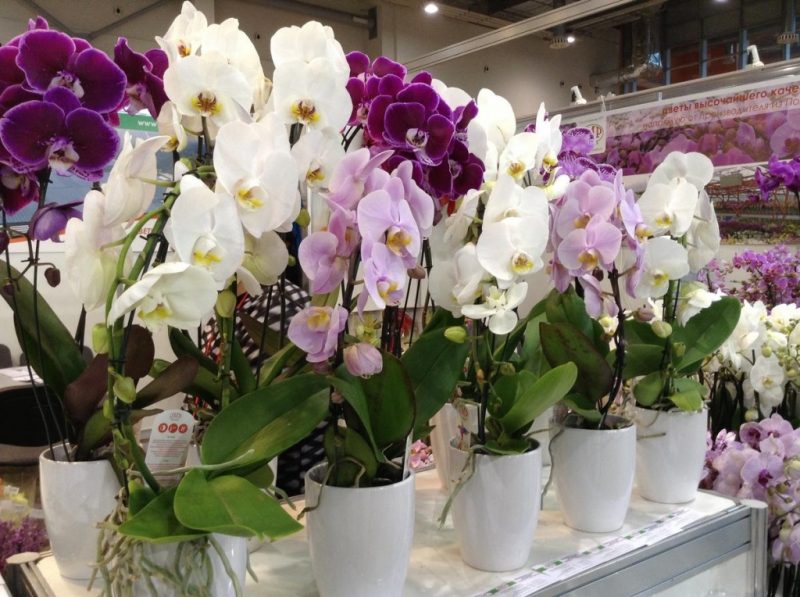
For an orchid, changing the place where it grew is stress. Therefore, it should not be transplanted into a new pot immediately after purchase. She needs a period for acclimatization in the new conditions. At first, in the first two days, the conditions in which she was to be imitated should be imitated and only then transplanted into another pot.
For transplantation, you need to take a good loose substrate, which absorbs a lot of moisture. After all, orchids do not grow on the soil, on the roots of trees. Therefore, crushed bark, most often pine, is taken as the basis. However, if even a drop of resin is found in such a substrate, the plant will die.
To clean the bark from the resin, to disinfect, it is first boiled in boiling water over low heat for a couple of minutes. Then the water is drained, the resulting mass is cooled and well ground. While the bark is moist, it can easily be cut into pieces, a couple of centimeters in size.
Having liberated the plant from the old substrate, carefully remove it from the pot and examine the roots. If there are slightly rotten or dry tips of the roots, they are carefully cut off. It is advisable to clean the entire root system.
The plant is carefully placed in a new pot, covered with prepared fresh and moist substrate and not watered. Only the next day you can water the orchid.



